In the fast-paced world of digital advertising, choosing the right ad format is crucial. It’s just as crucial as choosing the correct ad network. The 300 x 250 ad format stands out as a popular choice. Known as the “medium rectangle,” it offers versatility and effectiveness.
This ad size is widely used across various platforms. It fits seamlessly into web pages, mobile apps, and more. Its popularity is no accident. The 300 x 250 pixels format balances visibility with user-friendliness.
For e-commerce business owners, this format can boost brand visibility. It helps in reaching target audiences effectively. Digital marketing managers find it adaptable to changing trends. It supports innovative strategies that drive results.
Affiliate marketers also benefit from this format. It offers opportunities to maximize revenue through strategic placements. The 300×250 ad size is supported by most ad networks. This ensures broad reach and scalability.
Understanding this ad format is key to digital marketing success. It offers creative flexibility and high performance. In this guide, we’ll explore its benefits and best practices. Let’s dive into the world of the 300 x 250 ad format.
What is the 300 x 250 Ad Format?
The 300 x 250 ad format, often called a “medium rectangle,” is a staple in digital advertising. It measures 300 pixels in width and 250 pixels in height, making it compact yet visible. This balance makes it a favorite among advertisers and publishers alike.
This ad size is incredibly versatile. It fits well into content areas, sidebars, and even between paragraphs on a webpage. Its adaptability extends to mobile platforms, maintaining quality across devices.
The 300×250 ad format can host a variety of ad types. These include:
- Text ads
- Image-based ads
- Rich media content
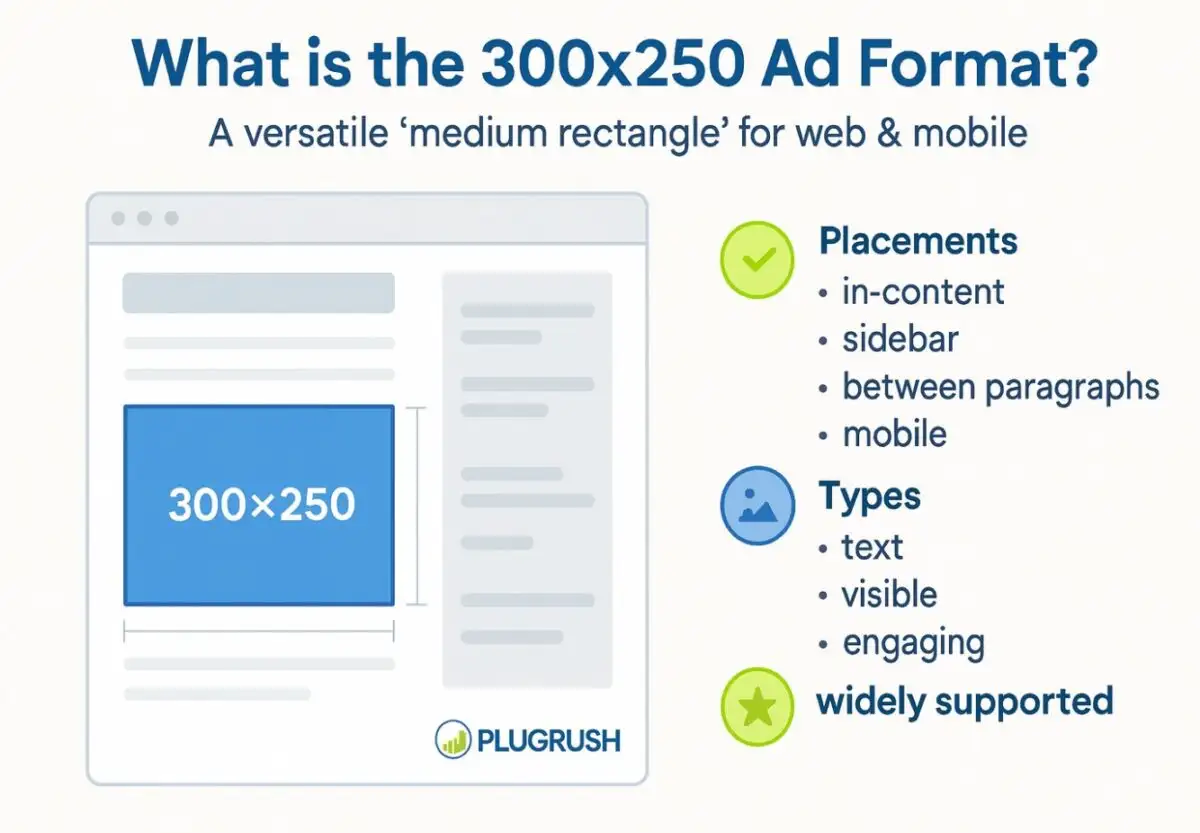
Such versatility allows for creative freedom, accommodating various advertising goals.
Advertisers appreciate its effectiveness in grabbing user attention without being intrusive. Its size and placement can enhance user engagement, making it ideal for a range of campaigns. Whether for brand awareness or direct sales, the 300×250 ad format meets diverse marketing needs. Its widespread use across ad networks like Google AdSense further underscores its appeal and reliability in the digital marketing ecosystem.
Why is the 300×250 Ad Size So Popular?
The popularity of the 300×250 ad size stems from its unique blend of visibility and flexibility. Its dimensions provide ample space for engaging visual content without overwhelming users. This balance is crucial in maintaining user-friendly web experiences.
Advertisers value the 300×250 ad for its adaptability across digital platforms. It functions effectively on desktops, tablets, and mobile devices, ensuring broad reach. It fits into various site layouts seamlessly, boosting its applicability for different web designs.
Several factors contribute to its widespread use:
- Enhanced Engagement: Its visibility captures user attention effectively.
- Creative Freedom: Supports diverse ad formats including video and interactive ads.
- Broad Compatibility: Integrates with major ad networks like Google AdSense.
- Cost Efficiency: Often delivers high returns at a reasonable cost.
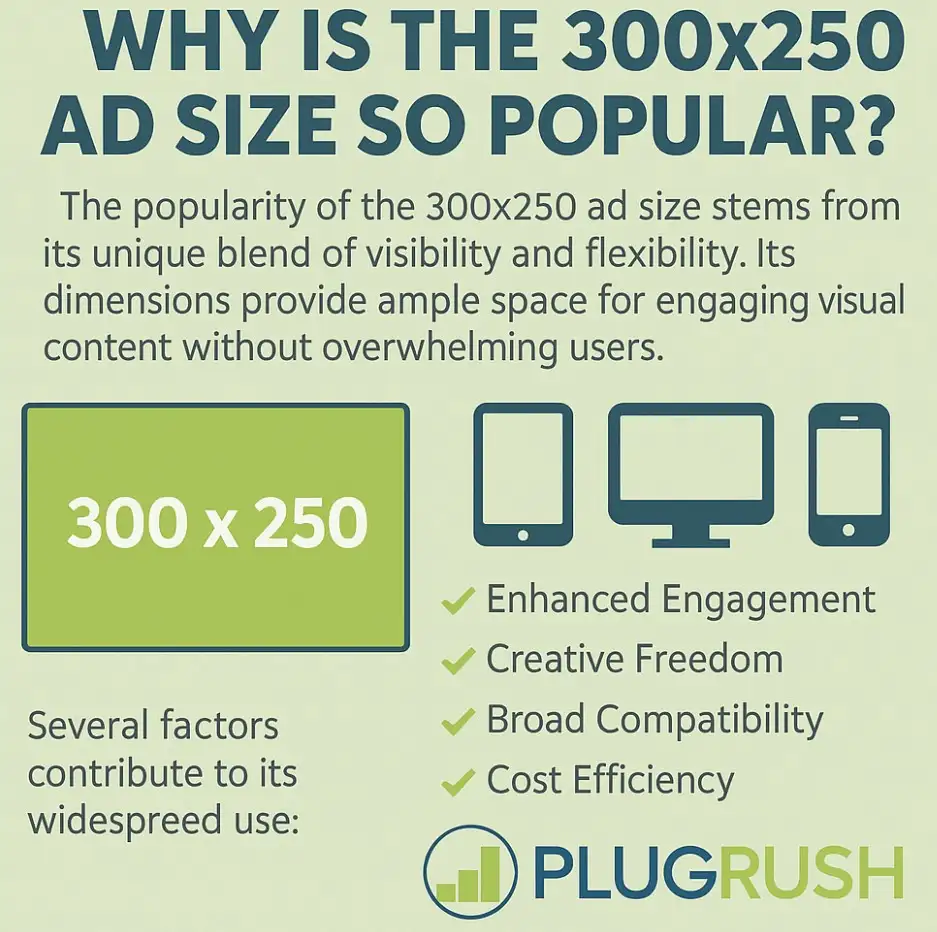
These attributes make the 300×250 banner a reliable choice for campaigns aiming to maximize engagement without inflating budgets. Its continued relevance in a fast-evolving digital landscape underscores its strategic importance in advertising.
Key Specifications and Technical Details
The 300×250 ad format, also known as the medium rectangle, is a staple in digital advertising. Its dimensions are 300 pixels wide and 250 pixels tall. This format is ideal for a wide range of advertising content, including images, text, and rich media.
When designing 300×250 ads, keeping file size and type in check is crucial. Most ad networks have specific guidelines. For example, Google Ads recommends a maximum file size of 150 KB to ensure quick loading times. This helps maintain a smooth user experience, even on slower internet connections.
Here are some key technical aspects to consider:
- Aspect Ratio: 6:5
- Common Formats: JPEG, PNG, GIF, HTML5
- Maximum File Size: Typically 150 KB
- Ad Serving Platforms: Compatible with Google AdSense and DoubleClick
These specifications are foundational for optimal ad performance. Advertisers should adhere to them to ensure their ads are displayed correctly and attractively across different platforms.
Where Can You Use 300×250 Ads? (Web, Mobile, Apps, and More)
The versatility of the 300×250 ad size makes it suitable for various digital environments. This adaptability allows advertisers to deploy these ads across numerous platforms to broaden their reach. In addition to websites, the format performs well on mobile devices, ensuring accessibility across different screens.
In the realm of websites, the 300×250 ad can be strategically placed in content areas, sidebars, or as part of header placements. These locations often lead to high visibility and engagement due to their central or prominent positioning. The ad’s size ensures it fits seamlessly without disrupting user experience.
Mobile usage of the 300×250 banner is also extensive. Due to its balanced dimensions, it perfectly suits mobile screens, delivering a clear and concise message. Many app developers also favor this format for in-app advertising, capitalizing on its adaptability.
Here’s where you can effectively use 300×250 ads:
- Websites: Content areas, sidebars
- Mobile: Optimized for mobile browsing
- Apps: Suitable for in-app advertising
- Email Campaigns: Inline and compatible with most layouts
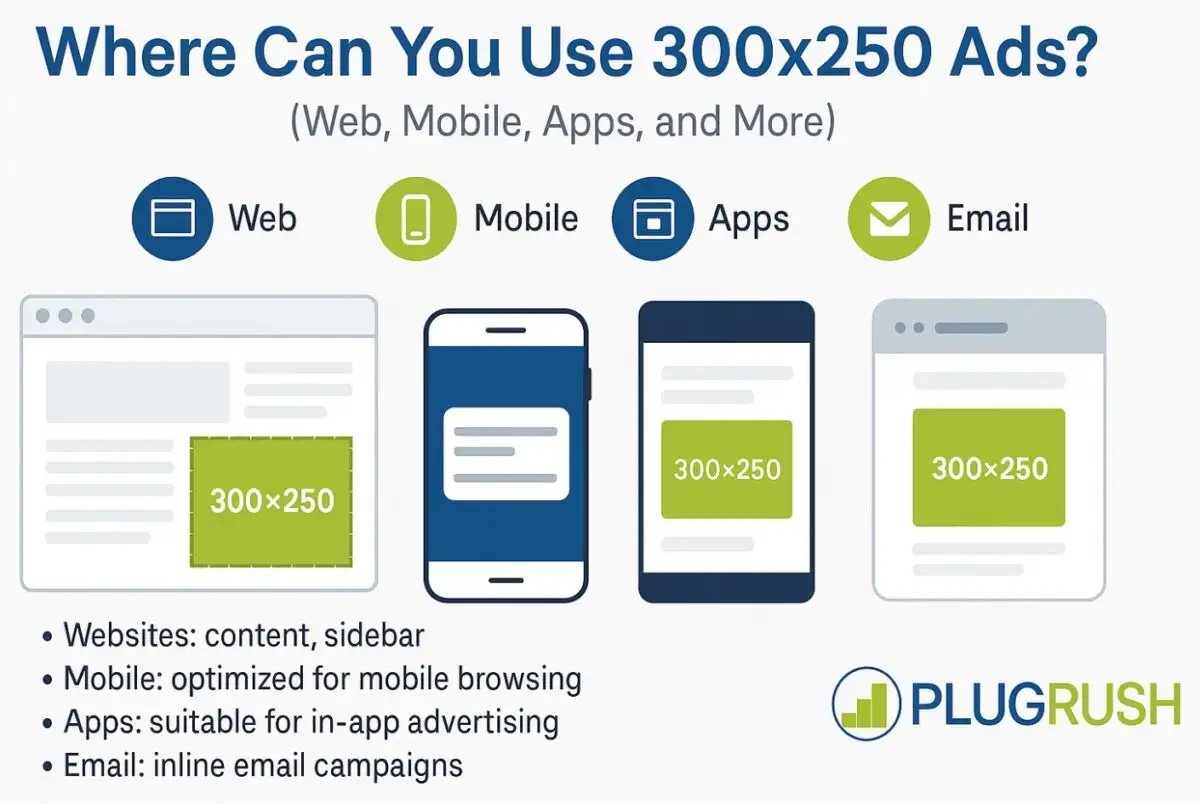
This ad format’s flexibility supports various advertising goals, from brand awareness to direct response campaigns.
Benefits of the 300 x 250 Pixels Format for Advertisers and Publishers
The 300 x 250 pixels format stands out for its unique advantages, making it a preferred choice for both advertisers and publishers. Its wide acceptance across ad networks highlights its universal appeal and compatibility. This ad size aligns well with the goals of visibility and unobtrusiveness.
For advertisers, this format offers a cost-effective option to reach diverse audiences. It allows for creative flexibility, combining text and imagery seamlessly. This makes it ideal for crafting engaging ads that capture viewer attention and promote interaction.
Publishers benefit from the format’s compatibility with numerous placements, boosting potential ad revenues. Its size fits neatly into web designs, ensuring it doesn’t disrupt content flow. This helps maintain a pleasant user experience, enhancing viewer satisfaction.
Here’s what makes the 300 x 250 format valuable:
- Wide Compatibility: Supported by major ad networks.
- Creative Flexibility: Supports text, images, and rich media.
- Cost-Effectiveness: Yields a high return on investment.
- User-Friendly: Ensures a non-intrusive ad experience.
Both parties can leverage these advantages for optimizing ad campaigns and generating reliable revenue streams.
Best Practices for Designing Effective 300×250 Banner Ads
Creating an engaging 300×250 banner ad requires strategic design elements that enhance visibility and user interaction. Focus on clarity and brevity in your messaging to capture attention quickly. Keep your content straightforward; each element should have a clear purpose.
A high-quality image is crucial for attracting and retaining viewer interest. Choose images that are relevant to your message and resonate with your target audience. Strong visuals can make your ad stand out amidst the clutter.
Color schemes and fonts should be chosen carefully to ensure readability while reinforcing your brand identity. Use contrasting colors to make your ad pop, but keep it aligned with your brand palette.
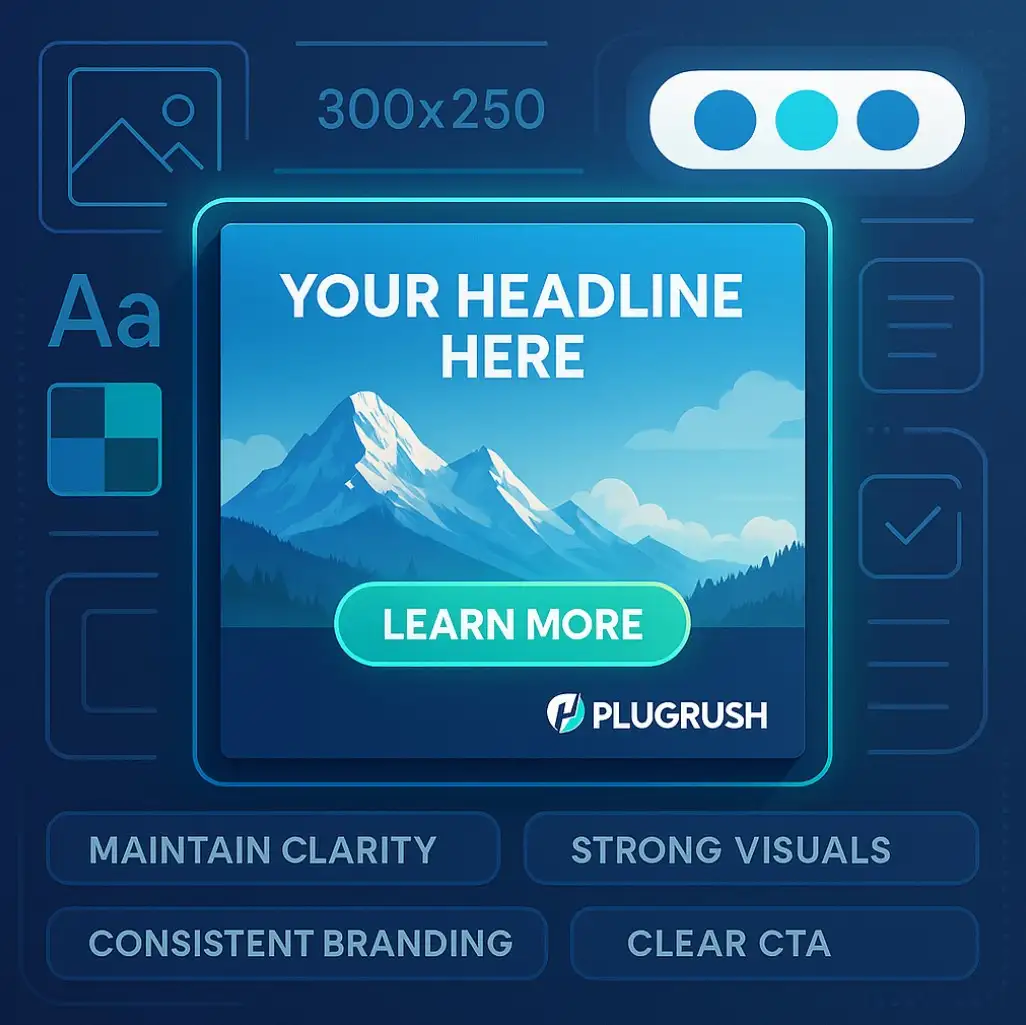
Each ad should include a clear call-to-action (CTA) that encourages users to engage further. The CTA should be prominent and compelling, guiding your audience toward the desired action.
When designing your 300×250 banner ad, remember these best practices:
- Maintain Clarity: Use concise text.
- Strong Visuals: Incorporate relevant, high-quality images.
- Consistent Branding: Stick to your brand’s color palette.
- Clear CTA: Direct users with a compelling call-to-action.
Applying these principles will help create an ad that not only attracts but also converts, maximizing the potential of your 300×250 banner.
Placement Strategies: Maximizing Visibility and Engagement
Strategic placement of your 300×250 banner ads can significantly boost their visibility and effectiveness. Positioning plays a pivotal role in capturing the audience’s attention and driving interactions. Consider areas that naturally draw a viewer’s eye as prime real estate for your ads.
Above-the-fold placements, which are visible without scrolling, tend to perform better in terms of visibility and engagement. This prominent positioning increases the likelihood that your ad will be seen immediately upon page load. However, below-the-fold placements can also be advantageous if they coincide with engaging content or interactive elements.
The context of where your ads appear is equally important. Analyze where your target audience spends their time and place ads on relevant sites or within relevant content. Understanding user behavior can help identify optimal ad locations.
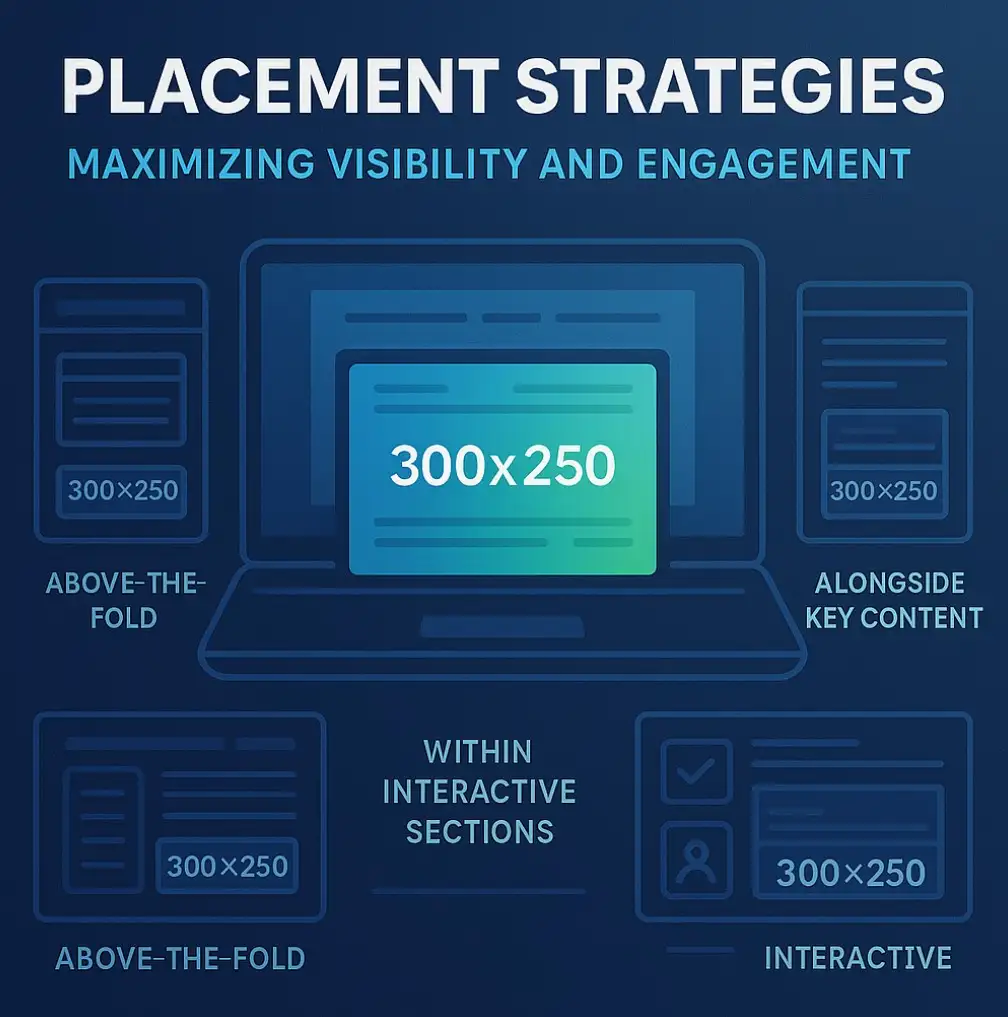
Some strategic placement ideas include:
- Above-the-Fold: Immediate visibility boosts exposure.
- Alongside Key Content: Align with engaging or related material.
- Within Interactive Sections: Pair with quizzes or polls for increased interaction.
By thoughtfully positioning your 300×250 ads, you can enhance both their visibility and engagement, making the most out of this versatile ad format.
Optimizing 300×250 Ads for Performance (A/B Testing, Analytics, and More)
Optimizing the performance of 300×250 ads is essential to achieving maximum return on investment. Begin by conducting A/B tests with various ad creatives to determine which designs resonate best with your audience. This method allows you to compare different elements, such as images, text, and calls-to-action, to see which combinations yield higher engagement.
Analytics tools play a crucial role in assessing the effectiveness of your ads. Monitor key metrics like click-through rates (CTR), conversion rates, and return on ad spend (ROAS) to gain insights into what works. These metrics can guide decisions on tweaking ad components for improved outcomes.
Experimentation is key, so don’t hesitate to test diverse ad strategies. Consider variations in color schemes, ad copy, and visuals to capture attention better. Regular reviews of performance data can uncover trends and provide direction for future optimizations.
To enhance ad performance, consider the following steps:
- A/B Testing Creatives: Test different elements to improve engagement.
- Analyzing Key Metrics: Focus on CTR, conversion rates, and ROAS.
- Experimenting with Designs: Try various visuals and copy variations.
Incorporating these optimization techniques will ensure your 300×250 ads perform effectively, driving targeted results and maximizing your advertising efforts.
Common Mistakes to Avoid with 300×250 Banner Ads
When using the 300×250 banner ad format, advertisers often make some common errors. One mistake is failing to optimize ads for all devices. Ensure your ads are responsive and load quickly on both desktop and mobile.
Another frequent error involves neglecting the ad’s visual and textual quality. Low-quality images or unclear messaging can deter engagement and diminish the effectiveness of an ad campaign. Always prioritize clarity and professional design.
It’s also easy to overlook proper targeting, leading to irrelevant impressions. Ensuring your ads reach the right audience is crucial for success. Avoid these pitfalls by focusing on these key areas:
- Device Responsiveness
- Quality of Visuals and Text
- Audience Targeting
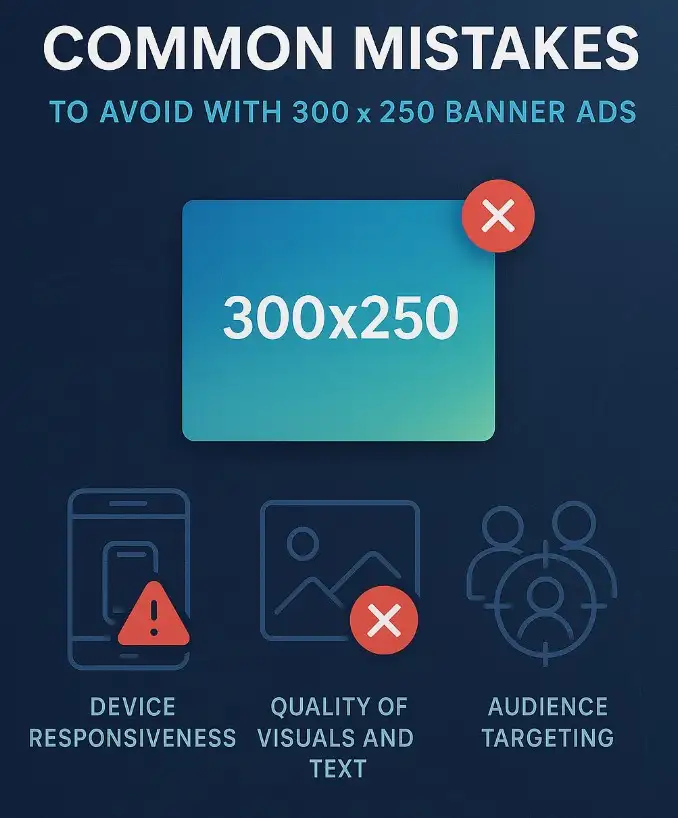
By steering clear of these common errors, you can enhance the impact and efficiency of your 300×250 banner ads.
Case Studies: Success Stories Using the 300×250 Ad Format
Numerous brands have leveraged the 300×250 ad format with notable success. One e-commerce company increased its sales by 30% by strategically placing 300×250 ads in high-traffic areas of relevant sites. This success demonstrated the format’s power in driving direct conversions.
Another example is a digital publisher who boosted user engagement by using dynamic content in 300×250 ads. This publisher saw a 50% increase in click-through rates through tailored ad creatives. Their use of animation within the ad format captured audience attention and led to significant interaction.
Additionally, a software company utilized 300×250 ads for lead generation, targeting tech blogs and forums. By aligning ad messaging with user interests, they achieved a 25% increase in qualified leads. These diverse success stories showcase the format’s versatility and effectiveness across various industries.
Key Takeaways from Success Stories:
- Strategic Placement: Increases visibility and conversions.
- Dynamic Content: Enhances engagement rates.
- Targeted Messaging: Boosts lead quality.
Integrating 300×250 Ads into Affiliate and E-commerce Strategies
The 300×250 ad format is a powerful ally for affiliate marketers seeking to maximize earnings. Its adaptable size allows for seamless integration into various content types, from reviews to product showcases. By aligning the ad content with audience interests, affiliates can see increased clicks and conversions.
E-commerce businesses can also benefit significantly from using 300×250 ads. These ads can boost brand visibility and drive traffic directly to product pages. The format’s compact size is ideal for highlighting product features or seasonal promotions without overwhelming the viewer.
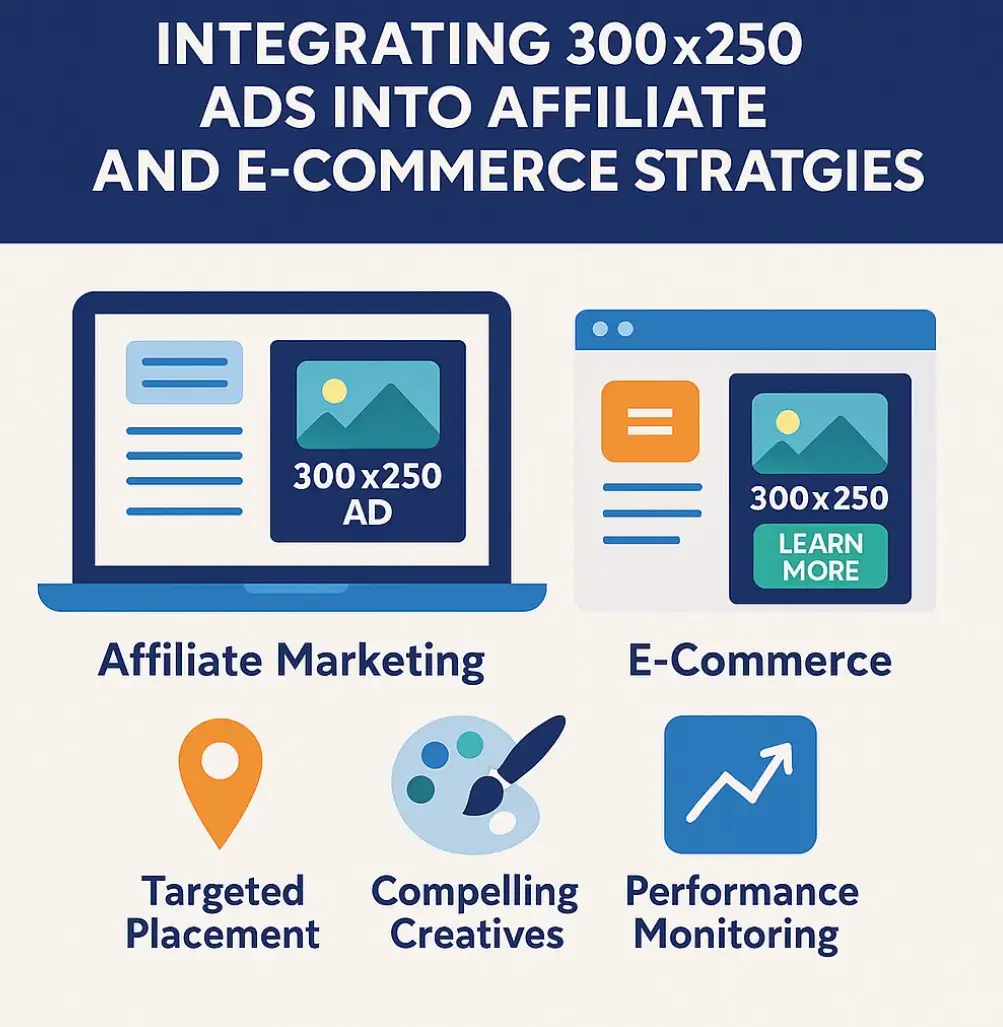
For optimal integration, marketers should consider the following strategies:
- Targeted Placement: Use data to identify where the audience congregates.
- Compelling Creatives: Craft engaging visuals and persuasive text.
- Performance Monitoring: Regularly track metrics to refine strategies.
By adopting these strategies, both affiliates and e-commerce platforms can leverage 300×250 ads to enhance visibility and achieve business goals.
Future Trends: The Evolution of the 300×250 Web Banner
The digital landscape is ever-evolving, and the 300×250 ad format is no exception. As technology advances, we can expect this format to adapt, incorporating more interactive and engaging features. Enhanced animations and interactive elements are likely to become more commonplace.
Additionally, the integration of artificial intelligence and machine learning into ad design will enable smarter targeting. These technologies can optimize ad display in real-time, aligning ads more closely with user preferences and behaviors. This will result in more personalized ad experiences, boosting engagement rates.
Looking ahead, here are some potential developments:
- Interactive Content: Increased use of gamification and quizzes.
- AI-Driven Personalization: Tailored ads based on user data.
- Rich Media Integration: More dynamic, multimedia content.
By staying informed about these trends, marketers can ensure their strategies remain relevant and impactful in a competitive digital space.
Conclusion: Making the Most of the 300×250 Banner Ad
In the competitive world of digital advertising, understanding and mastering the 300×250 banner ad is crucial. This versatile format offers a perfect mix of visibility and user-friendliness, ensuring it remains a favorite choice for advertisers.
By leveraging creative design, strategic placement, and analytical insights, marketers can significantly enhance their ad performance. Regularly updating and testing creatives will keep the audience engaged and your campaigns successful. Adapting to trends ensures this ad format stays effective and impactful in your marketing arsenal.




